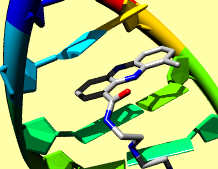Raytracing with POV-Ray
The Persistence of Vision Raytracer (POV-Ray)
is included with Chimera. POV-Ray images can be saved:
Raytraced images can only be saved in the PNG format.
For each raytraced image, Chimera first generates two POV-Ray input files:
- scene description (*.pov file)
- raytracing options (*.ini file)
The raytracing calculation is then run as a background job
that can be monitored or canceled using the
Task Panel.
Several raytracing parameters can be set in the
POV-Ray Options
preferences.
See also:
exporting a scene,
tips on preparing images
Lights and Shadows
Chimera includes two light sources,
key (dominant) and fill (secondary).
Their directions and intensities can be adjusted in the
Lighting tool
and are propogated to POV-Ray for raytracing.
By default, only the key light produces shiny highlights and shadows.
Decreasing the key-to-fill ratio
will decrease the contrast between shadows and unshadowed regions.
Interactive shadowing in Chimera (the
show shadows setting in
Effects) can be used to
preview where shadows will fall.
Balancing Time Requirements and Results
Sometimes a considerable speedup in raytracing can be obtained with
little change in output appearance by adjusting settings in the
POV-Ray Options
preferences. This is particularly true for
movies,
which are compressed to some extent during encoding.
Changes to consider include:
- decreasing the
quality to 4 or 5
[quality details at the POV-Ray site]
- increasing the
antialias threshold
to 1.5 or even higher (maximum 3.0)
[antialias details at the POV-Ray site]
- if objects are not intentionally sliced, making sure that
global clipping is turned off;
to adjust depth cueing, use the start and end parameters in
Effects
rather than moving the global clipping planes, which would turn clipping on
There is no single answer as to which values will optimally balance
time requirements and results, as it will depend on the contents of the
scene, the available computational power, and the patience of the user.
Running a few tests is recommended before committing to raytracing
a large set of images with a particular set of parameters.
Raytracing jobs can be monitored and canceled using the
Task Panel.
Limitations
Using transparency or clipping
may increase rendering time significantly.
A raytraced image from POV-Ray may differ from the view in Chimera
in several ways. Some differences are desirable, such as the presence
of shadows. Others reflect current limitations of the POV-Ray format
and/or its implementation in Chimera:
- colors may differ slightly
- shading along ribbons
may be stairstepped; using the supersmooth style instead of
rounded reduces this effect
- light source directions but not
colors are translated from Chimera
- although object
shininess and brightness levels
(but not specular color) are translated from Chimera, objects tend
to appear shinier in the raytraced image (perhaps a desired effect)
- if depth cueing is used,
the background of the raytraced image:
- the following are omitted or otherwise not handled:
silhouettes,
selection highlighting,
stereo,
Volume Viewer transparent solid displays,
and normals on dot and mesh surfaces
- max_trace_level is set to 10 to improve multi-level transparency,
but this also increases time and memory requirements relative to lower levels
[details at the POV-Ray site]
UCSF Computer Graphics Laboratory / August 2009

